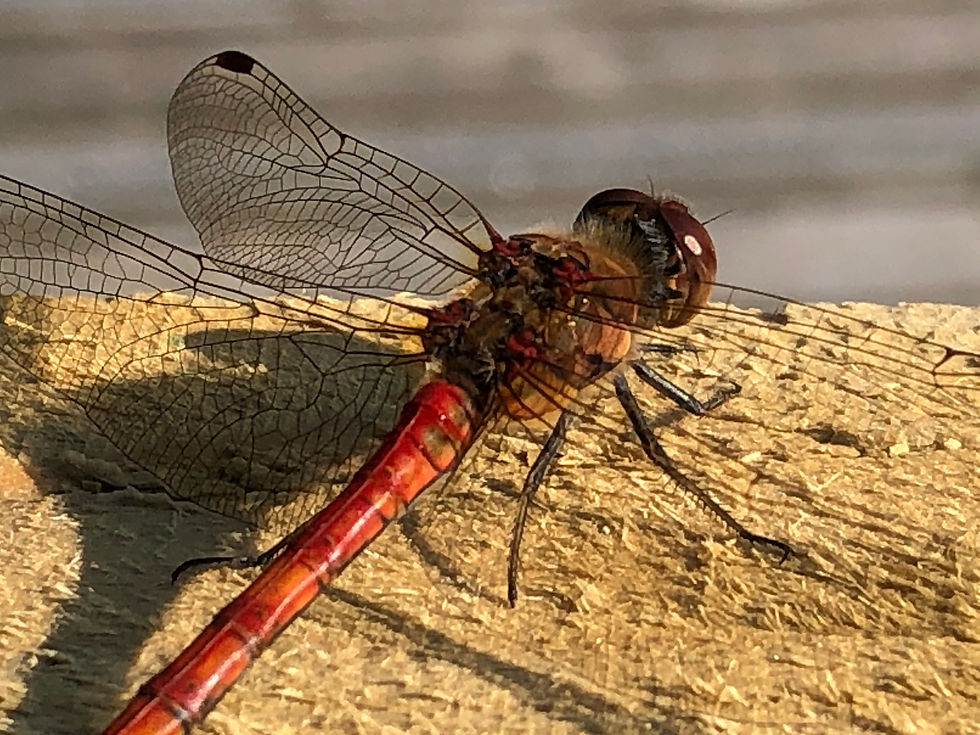Dragonflies of Speyside
- Harris Brooker
- Jun 3, 2024
- 4 min read
Dragonflies and damselflies are an ancient group of insects that have been around on Earth since the Carboniferous Era 358 - 298 million years ago. Back then in the lush, oxygen rich climate they could grow to the size of cartwheels. Dragonflies of that size have since disappeared. Here’s an account of some their smaller descendants that now roam the wetlands of Speyside today.
Large Red Damselfly (Pyrrhosoma nymphula) - This is one of the earliest damselflies to appear and is easily identified by its red and black abdomen and has black legs, which tells it apart from a similar species not found in Speyside called the Small Red Damselfly. The male has thin black stripes on the abdominal sections which end in a section of three black bands, the top third one having the biggest section of black. Females are similar but have larger black sections on the abdomen with yellow markings underneath. Can be easily found in wetland areas like ponds, lakes, rivers and canals. They are around from mid-April to the end of August.


Common Blue Damselfly - One of the commonest damselfly species in Speyside. Males are blue and black, females are black with either a blue or dull green colouration and has a thistle shaped mark just below the wing base with rocket shaped markings down the rest of the abdomen. At the top of the abdomen the males have a black mushroom shaped marking that tells it apart from the similar Northern Damselfly which has a spade shaped marking. Found from May to September.


Northern Damselfly - A localised damselfly species that looks outwardly like a Common Blue Damselfly but is much thinner, more delicate looking and has a spade shaped marking at the top of the abdomen. Has more black on the thorax and thinner blue stripes there too. The male is blue and the female looks green side on, though is mostly black above. Found in June and July.

Emerald Damselfly (Lestes Sponsa)- A widespread damselfly and the commonest of the three Emerald Damselfly species that occur in the UK. Males are more bluish with a shiny green thorax. The female is greener overall. It can be abundant in places, especially in still waters with tall vegetation like rushes and sedges. They appear from June to August.


Common Darter (Sympetrum Striolatum) - Males have red abdomens, with yellow patches on the side and females have yellow abdomens, though they become duller and more reddish with age. Can be at home in virtually any wetland area including ponds, ditches, rivers and lakes. Darters are named for their habit of hunting which involves sitting and waiting for prey to come past it, then ‘darting’ forwards to catch it where they then return to a perch to eat it. Found from June to November, though the autumn months may not necessarily apply to Speyside.


Four Spotted Chaser - (Libellula Quadrimaculata) - A medium sized dragonfly that is fairly broad bodied, with a brown abdomen and yellowish colouration down the side of its body. It’s named for its four spots on the wings, four per wing and only on the frontal edge. Males and females look alike. Has an erratic flight interspersed with hovering and often likes to return to the same perch which makes photographing them comparatively easy. Sometimes referred to as the ‘Flying Cigar’. Found from May to August.

Golden Ringed Dragonfly (Cordulegaster Boltonii) - One of the largest dragonflies. The adults have black abdomens with thick black stripes. Like other dragonfly species, it can be seen dipping its abdomen in the water to lay its eggs, a behaviour known as ovipositing. Likes to breed in acidic rivers and stagnant water and may be found in heathland. Found from June to August.

Common Hawker (Aeshna Juncea) - A large dragonfly. Males have black abdomens with one row of blue spots. They have two yellow stripes on the abdomen that are known as ante-humeral stripes. Females have greenish blue spots and either have very small ante-humeral stripes or they are absent. Likes wetland areas, including bog lands. Found from June to September.


White Faced Darter (Leucorrhinia Dubia) - One of the most localised dragonflies in Speyside. Males are coloured red and black on the thorax and abdomens and females have yellow and black ones. Each has its namesake white face. Likes acidic bog pools with plenty of sphagnum moss in which to lay eggs and have their larvae hatch. Found from May to July.


Northern Emerald (Somatochlora Arctica)- One of the most localised dragonflies in Speyside. They have black abdomens with a greenish sheen that is only seen when the light catches them right. Males have a pinched appearance to their waists whereas on females it’s more parallel sided. Very difficult to approach and will fly away at any modest attempt. They breed in bog land pools with plenty of Sphagnum moss and the adults will hunt in wet meadows, open areas within pine forests or on moorland with scattered trees. Found from June to July.


Azure Hawker - One of the rarest dragonflies in Britain. This one is relatively unlikely to be seen in Speyside but is included here because of its similarity with the Common Hawker. Has a mostly blue abdomen with black spots. Female looks darker. In females a brown form also exists as well as the usual blue one. Likes boggy moorland where it can happily perch on tree trunks and rocks. Found from June to July.

If you fancy a chance to see dragonflies on a day out go to: http://bit.ly/sw_DG



Comments